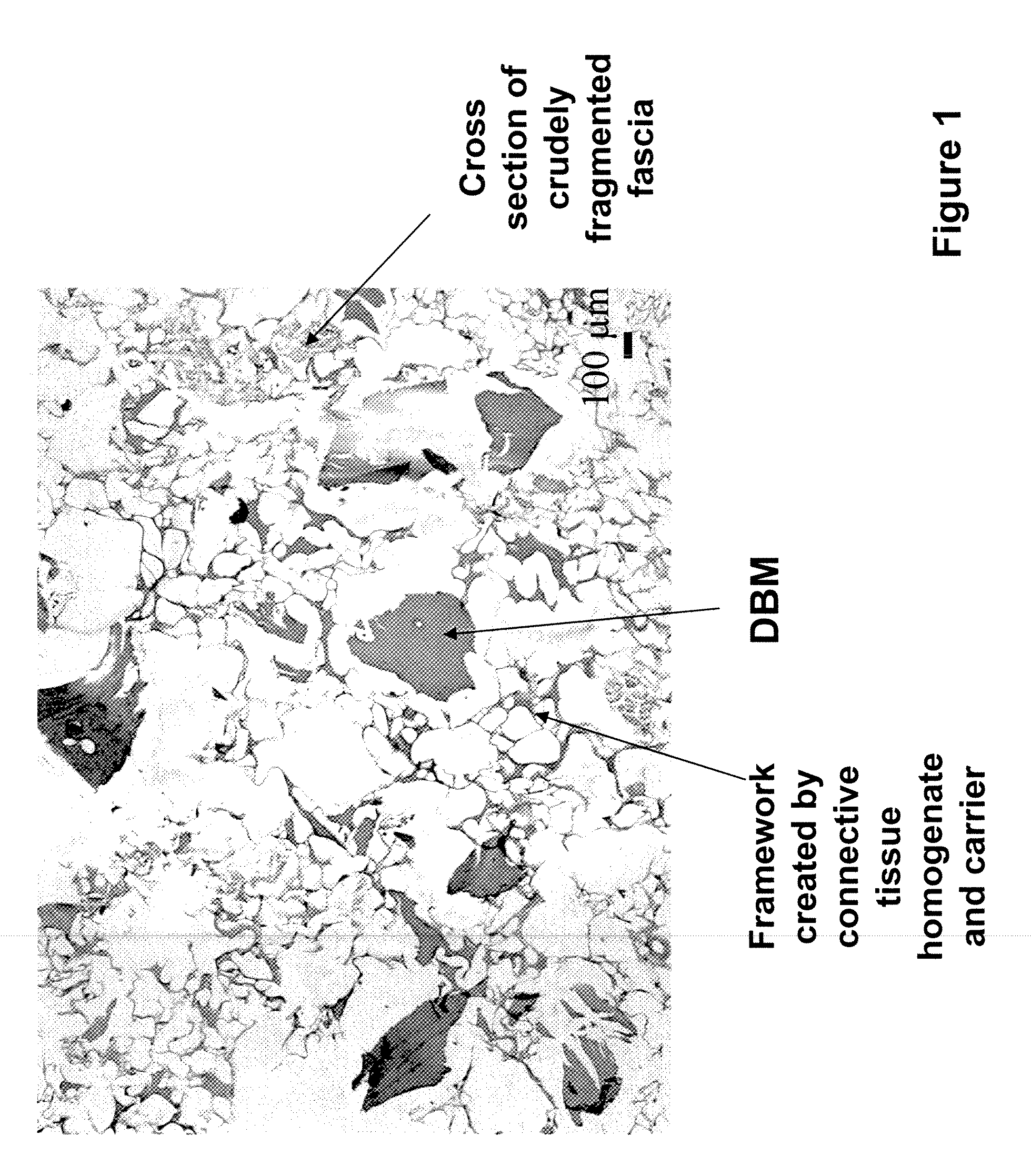Composition for a Tissue Repair Implant and Methods of Making the Same
a tissue repair and implant technology, applied in the field of tissue repair implants, can solve the problems of limiting each, and achieve the effect of increasing the affinity of growth factors
- Summary
- Abstract
- Description
- Claims
- Application Information
AI Technical Summary
Benefits of technology
Problems solved by technology
Method used
Image
Examples
example 1
[0082]Preparation of Tissue Repair Implants: Porous Sponge-Like Structure with DMB Particles.
[0083]Fascia lata and bone from a human cadaver were procured and returned to the processing facility under sterile conditions. Donor histories, personal and medical, were obtained following accepted standards of the American Association of Tissue Banks. Microbiological tests were performed following FDA guidelines for testing sterility of products.
[0084]The bone and fascia were cleaned of unwanted tissues and freeze-dried. The freeze-dried fascia was cut into small (about 1.5 cm by 1.5 cm) pieces (e.g., crude fragments). Sterile water in a volume (1 cm3 of isotonic saline corresponds to about 1 g) approximating 20 times the weight of tissue, was added to a container containing the cut fascia. The ingredients were heated to a temperature of 100 degree C. using a hot plate, and maintained at this temperature for about 5 minutes. Optionally, water was added to the heated composition to replace...
example 2
[0089]Preparation of Tissue Repair Implants: Porous Sponge-Like Structure without Bone Fragment.
[0090]The homogenized fascia, sodium alginate solution, crudely fragmented fascia, and CaCl2 solution were prepared as described in Example 1.
[0091]To prepare the tissue repair implant, the homogenized fascia was mixed with a sodium alginate solution first to produce a connective tissue carrier, which was mixed further with crudely fragmented fascia. After mixing all the components, the mixture was distributed into molds with pre-determined shapes and sizes, freeze-dried, treated with CaCl2, washed, and freeze-dried again. Before the first freeze-drying cycle, some samples were exposed to a negative hydrostatic pressure to allow the expansion of the mixture to a preset thickness. The resultant porous sponge-like structure was then sent out for sterilization by gamma irradiation.
[0092]In one of the tissue repair implants, the porous sponge-like structure contained about 20% alginate, 60% h...
example 3
[0093]Preparation of Tissue Repair Implants: Porous Sponge-Like Structure with DBM Particles and DMB Fiber Bone.
[0094]The homogenized fascia, sodium alginate solution, crudely fragmented fascia, demineralized bone powder, and CaCl2 solution were prepared as described in Example 1.
[0095]Demineralized fiber bone was prepared by cutting cortical bone to produce cut fiber bone having an average length from about 1 mm to about 100 mm. Then the cut fiber bone was cleaned and disinfected, and a total of 463 grams of bone materials were dermineralized to 2.5% residual calcium using 2 cycles of 0.5 N HCl and acid volumes of 4.0 liters / cycle and 3.0 liters / cycle, 1 cycle of ultrapure water of 3.0 liters / cycle, and 2 cycles ultrapure water plus buffer of 3.0 liters / cycle to terminate the demineralization process. The bone fibers were finally washed in 3.0 liters of ultrapure water, stored frozen at −80 degree C. in a sterile container, and freeze-dried for 96 hrs.
[0096]To prepare the tissue re...
PUM
 Login to View More
Login to View More Abstract
Description
Claims
Application Information
 Login to View More
Login to View More - R&D
- Intellectual Property
- Life Sciences
- Materials
- Tech Scout
- Unparalleled Data Quality
- Higher Quality Content
- 60% Fewer Hallucinations
Browse by: Latest US Patents, China's latest patents, Technical Efficacy Thesaurus, Application Domain, Technology Topic, Popular Technical Reports.
© 2025 PatSnap. All rights reserved.Legal|Privacy policy|Modern Slavery Act Transparency Statement|Sitemap|About US| Contact US: help@patsnap.com



